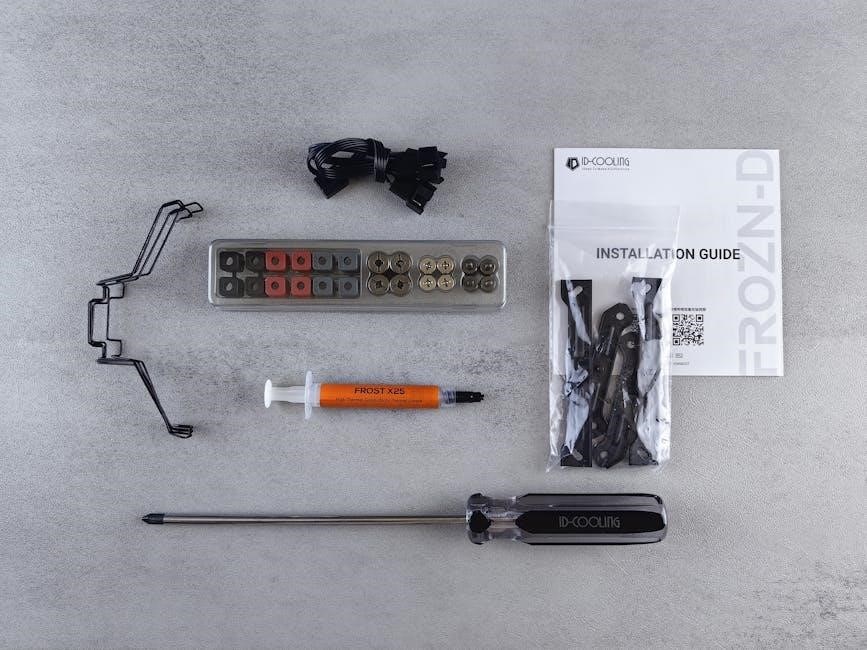The Honeywell TH5220D1029 is a non-programmable digital thermostat designed for 2-stage heating and cooling systems. It offers precise temperature control, easy installation, and compatibility with heat pumps. Ideal for homeowners seeking a reliable, user-friendly solution for managing their HVAC systems efficiently.
1;1 Overview of the Thermostat Features
The Honeywell TH5220D1029 is a non-programmable digital thermostat designed for simplicity and efficiency. It features a backlit digital display, compatibility with 2-stage heating and cooling systems, and support for heat pumps. The thermostat is battery-powered, eliminating the need for a common wire (C-wire), and includes a easy-change battery door. Its intuitive interface allows for straightforward temperature adjustments, and it comes with a wallplate for easy installation. The device also supports auto-changeover between heating and cooling modes, ensuring optimal comfort year-round.
- Digital, non-programmable design for easy operation.
- Backlit display for clear temperature readings.
- Compatibility with 2-stage systems and heat pumps.
- Battery-powered with easy-change door.
- Auto-changeover for seamless mode switching.
1.2 Importance of Proper Installation
Proper installation of the Honeywell TH5220D1029 thermostat is crucial for accurate temperature control and system performance. Incorrect wiring or mounting can lead to issues such as no power, incorrect temperature readings, or system malfunctions. Ensuring the wallplate is level and securely fastened guarantees precise temperature sensing. Following the manufacturer’s installation guide helps prevent common errors and ensures optimal functionality. Proper setup also simplifies future troubleshooting and maintenance, ensuring reliable operation of your heating and cooling systems.
- Ensures accurate temperature readings.
- Prevents wiring and system malfunctions.
- Guarantees safe and efficient operation.

Pre-Installation Checklist
- Verify system compatibility (heat pump or conventional).
- Check power supply options (battery or hardwired).
- Gather necessary tools and materials.
- Ensure safety precautions are in place.
- Review the installation manual thoroughly.
2.1 Compatibility Check for Heating and Cooling Systems
Before installation, ensure the Honeywell TH5220D1029 is compatible with your HVAC system. It supports 2-stage heating and cooling systems, including heat pumps. Verify the system type by checking the existing wiring and thermostat setup. For heat pumps, confirm the wiring terminals match the thermostat’s requirements. If unsure, consult the official manual or contact Honeywell support for assistance. Proper compatibility ensures optimal performance and avoids installation issues.
2.2 Safety Precautions Before Starting the Installation
Before installing the Honeywell TH5220D1029, switch off the HVAC system at the circuit breaker. Ensure the furnace door is securely closed to prevent accidental start-ups. Verify that all power sources are disconnected to avoid electrical shocks. Wear protective gear like gloves and safety glasses. Keep the work area clear of flammable materials. If unsure about any step, consult a licensed electrician. Safety is crucial to prevent injuries and ensure a successful installation.
2.3 Tools and Materials Required
To install the Honeywell TH5220D1029 thermostat, gather the following tools: a flathead and Phillips screwdriver, wire strippers, a voltage tester, and a level tool. Materials needed include 18-22 gauge thermostat wire, non-flammable insulation for wall openings, and drywall anchors or screws for wallplate mounting. Ensure you have fresh AA or AAA batteries if using the battery-powered option. Having all tools and materials ready will streamline the installation process and ensure a smooth setup.

Wallplate Installation
Mount the wallplate on a flat surface, ensuring it is level and secured firmly to the wall. This provides a stable base for the thermostat, ensuring accurate temperature readings and proper functionality.
3.1 Mounting the Wallplate
Begin by loosening the screw terminals on the wallplate to insert the thermostat wires. Gently push any excess wire back into the wall to keep the area organized. Ensure the wallplate is level using a carpenter’s level for accurate temperature readings. Secure the wallplate to the wall using the provided screws, making sure it is tightly fastened. Properly insulate the wall opening with non-flammable material to prevent drafts from affecting the thermostat’s performance. A stable installation ensures reliable functionality.
3.2 Leveling the Wallplate for Accurate Temperature Reading
Proper leveling of the wallplate is crucial for accurate temperature readings and optimal system performance. Place a carpenter’s level on the wallplate and ensure the bubbles align in the center, indicating it is perfectly horizontal. Adjust the wallplate as needed by loosening or tightening the mounting screws. Make sure the surface is plumb and the wallplate is secure. For uneven walls, use shims to achieve a level surface. Accurate leveling ensures the thermostat operates correctly and provides reliable temperature control.
3.4 Securing the Wallplate to the Wall
Once the wallplate is properly leveled, secure it to the wall using the provided screws. Ensure the screws are tightened firmly to prevent any movement. If installing in a hollow wall, use drywall anchors for added stability. Tighten the screws evenly to avoid warping the wallplate. Double-check that the plate is flush against the wall and aligned correctly. Proper securing ensures the thermostat operates accurately and maintains a stable connection with the HVAC system for optimal performance.

Wiring the Thermostat
Connect the wires to the terminal block by loosening the screw terminals, inserting the wires, and tightening the screws. Ensure proper wire organization and secure any excess wire back into the wall. Use non-flammable insulation to plug the wall opening, preventing drafts. Refer to the wiring diagram for specific terminal connections and power options (24 VAC or battery-powered).
4.1 Removing the Old Thermostat Wires
Start by switching off the power supply at the circuit breaker to ensure safety. Carefully remove the old thermostat faceplate by unscrewing it. Label each wire according to its terminal (e.g., R, W, Y, G, C) using markers or tags. Gently pull each wire out of the old terminal block, taking note of any jumpers or connectors that may need removal. Ensure no wires remain connected to the old thermostat and the area is clear for the new installation. This step ensures a smooth transition to wiring the new Honeywell TH5220D1029 thermostat.
4.2 Connecting the Wires to the Terminal Block
Match each labeled wire to the corresponding terminal on the Honeywell TH5220D1029. Loosen the screw terminals using a screwdriver, insert the wires, and tighten securely. Refer to the wiring diagram in the manual for correct terminal assignments (e.g., R, W, Y, G, C). Ensure no wires are loose or touching adjacent terminals. Double-check connections to avoid errors. Once all wires are connected, proceed to organize excess wire neatly behind the wallplate for a clean installation.
4.3 Organizing and Securing Excess Wire
Gently push excess wire back into the wall opening to keep the area tidy. Use wire clips or ties to secure any remaining wire, ensuring it does not interfere with the thermostat’s operation. Seal the wall opening with non-flammable insulation to prevent drafts, which could affect temperature readings. This step ensures a clean installation and maintains accurate thermostat functionality. Proper organization also simplifies future maintenance or upgrades.

Power Options and Mounting
The Honeywell TH5220D1029 offers dual power options: battery-powered or hardwired (24VAC). For hardwiring, connect the common transformer side to the C terminal. Remove the R/Rc jumper for 2-transformer systems. Battery installation is straightforward, with an easy-access door. Ensure proper mounting at 5 feet above the floor for accurate temperature sensing and optimal performance.
5.1 Battery-Powered vs. Hardwired Options
The Honeywell TH5220D1029 offers two power options: battery-powered or hardwired. Battery power is convenient, using AA or AAA alkaline batteries, eliminating the need for wiring. The easy-change battery door allows quick replacements without disassembling the thermostat. For a more permanent solution, the hardwired option connects to a 24VAC power source, ensuring continuous operation without battery replacements. Choose the option that best fits your installation preferences and system requirements for reliable performance.
5.2 Mounting the Thermostat on the Wallplate
Mounting the Honeywell TH5220D1029 thermostat on the wallplate is straightforward. Align the thermostat with the wallplate, ensuring proper fit and alignment. Snap the thermostat onto the wallplate until it clicks securely into place. Make sure the device is level and firmly attached to ensure accurate temperature readings and proper functionality. Once mounted, verify that all connections are secure and the thermostat is ready for operation. This step ensures a stable installation for reliable performance.
5.3 Ensuring Proper Power Supply
Ensure the Honeywell TH5220D1029 thermostat has a stable power supply. For battery-powered setups, install fresh AA batteries and secure the battery door. For hardwired systems, connect the common (C) terminal to the transformer’s common side. Remove the R/Rc jumper if using a two-transformer system. Verify all connections are secure and turn on the power. Check for proper functionality and refer to the manual for specific wiring diagrams to avoid power-related issues during operation.

Installer Setup and Configuration
Navigate the installer setup menu to configure system type, heating/cooling stages, and settings for heat pumps. Ensure proper system type selection for accurate operation and efficiency.
6.1 Navigating the Installer Setup Menu
Access the installer setup menu by pressing the menu button. Use arrow keys to scroll through options like system type, heating/cooling stages, and heat pump settings. Select desired configurations using the confirm button. Ensure settings match your HVAC system for proper operation. Adjust parameters like temperature differential and compressor cycle times. Save changes to ensure optimal performance. This step ensures compatibility and efficiency, especially for heat pump systems, by tailoring settings to your specific setup.
6.2 Configuring System Type and Stage of Heating/Cooling
Select the system type (conventional or heat pump) in the installer menu. Choose the number of heating and cooling stages (1 or 2). For heat pumps, configure auxiliary heat settings. Ensure settings match your HVAC system’s capabilities. Proper configuration ensures efficient operation and prevents damage. Use the arrow keys to navigate and confirm with the select button. Accurate setup guarantees optimal performance and energy efficiency tailored to your home’s specific heating and cooling needs.
6.3 Setting Up the Thermostat for Heat Pumps
For heat pump systems, select the correct system type in the installer menu. Configure auxiliary heat settings to optimize performance. Ensure terminals E and Aux are properly connected for auxiliary heat operation. Verify compatibility with your heat pump system’s specifications. Use 18-22 gauge thermostat wire and avoid shielded cable. Proper setup ensures efficient heating and cooling, preventing unnecessary auxiliary heat usage. Double-check wiring connections and system compatibility before finalizing the configuration.

System Testing and Verification
Test the heating and cooling systems to ensure proper operation. Verify temperature accuracy and system responsiveness. Check for any issues with wiring or functionality before finalizing the setup.
7.1 Testing the Heating System
To test the heating system, set the thermostat to “Heat” mode and raise the temperature above the current room temperature. Ensure the furnace or heating unit activates and runs smoothly. Verify that the system reaches the set temperature accurately. Check for any unusual noises or malfunctions. Use a multimeter to confirm power at the heating terminals. Ensure all safety features, like the furnace door switch, are functioning correctly. This step ensures reliable heating performance and system compatibility with the thermostat.
7.2 Testing the Cooling System
Set the thermostat to “Cool” mode and lower the temperature below the current room temperature to activate the cooling system. Ensure the air conditioning unit turns on and operates smoothly. Verify the system reaches the set temperature and maintains it consistently. Check for proper airflow through vents and inspect for any leaks or blockages. Test the system’s response to temperature adjustments and ensure it cycles correctly. This step confirms the cooling system’s functionality and compatibility with the thermostat.
7.3 Verifying Proper System Operation
Once both heating and cooling systems are tested, ensure the thermostat operates seamlessly. Verify consistent temperature maintenance, smooth transitions between modes, and correct system cycling. Check for any unusual noises, uneven airflow, or temperature fluctuations. Confirm all settings, such as fan operation and system type, function as configured. Ensure the display accurately reflects system status and user inputs. This validation step ensures the entire HVAC system performs efficiently and reliably under the thermostat’s control.

Post-Installation Checks
After installation, ensure the thermostat functions correctly, all wiring connections are secure, and the system operates as expected. Verify proper temperature control and system responsiveness.
8.1 Ensuring Proper Thermostat Functionality
After installation, verify that the Honeywell TH5220D1029 thermostat operates correctly. Check temperature accuracy, ensure all buttons respond, and confirm the display shows proper readings. Test heating and cooling modes to ensure smooth transitions. Make sure the thermostat cycles on and off correctly and maintains the set temperature. If any issues arise, refer to the troubleshooting guide or contact Honeywell support for assistance.
8.2 Checking for Any Wiring Issues
Inspect all wire connections to ensure they are secure and properly seated in the terminal block. Verify that no wires are loose or damaged. Check for any short circuits or incorrect wire placements. Ensure the R/Rc jumper is correctly configured if applicable. Consult the wiring diagram in the manual for accuracy. If issues persist, power down the system and review connections or contact Honeywell support for further assistance. Proper wiring is crucial for optimal thermostat performance.
8.3 Finalizing the Installation
After completing the installation, turn the power back on and test the thermostat by running a full heating and cooling cycle. Ensure all functions operate correctly and adjust settings as needed. Verify the thermostat is level and securely mounted. Double-check that all wires are neatly organized and excess wire is stored properly. Clean any debris from the area and ensure the thermostat face is clean for accurate readings. Refer to the manual for any final adjustments or settings customization.

Troubleshooting Common Issues
Common issues include no power, incorrect temperature readings, or the system not responding. Check wiring, battery levels, and system compatibility to resolve these problems effectively.
9.1 No Power to the Thermostat
If the thermostat has no power, first check the circuit breaker or fuse box to ensure the HVAC system’s power is on. Verify that all wiring connections are secure and not loose. For battery-powered models, inspect the battery terminals for corrosion and ensure batteries are fresh. If using a hardwired connection, confirm the C terminal is properly connected to the 24VAC power source. Consult the wiring diagram in the manual to ensure correct connections and troubleshoot further if issues persist.
9.2 Incorrect Temperature Readings
If the thermostat displays incorrect temperatures, ensure it is mounted level and in an area with good air circulation, avoiding direct sunlight or drafts. Check the battery terminals for corrosion and ensure fresh batteries are installed. Verify all wiring connections are secure and correct. If issues persist, reset the thermostat by removing batteries or power for 30 seconds. For severe inaccuracies, refer to the manual for calibration options or perform a system reset to restore default settings.
9.3 System Not Responding to Thermostat Commands
If the HVAC system doesn’t respond to thermostat commands, first ensure the thermostat has power and batteries are functioning. Check circuit breakers and switches at the heating/cooling system. Verify all wiring connections are secure and correct, especially the R, C, W, and Y terminals. If issues persist, ensure the system type and stage configuration in the installer setup menu match your equipment. Perform a system test to confirm proper operation and address any wiring or setup discrepancies promptly.
Proper installation ensures optimal performance and energy efficiency. The Honeywell TH5220D1029 is a reliable, user-friendly thermostat, ideal for homeowners seeking precise temperature control and compatibility with heat pump systems.
10.1 Summary of Key Installation Steps
Begin with a pre-installation checklist to ensure system compatibility and safety. Install the wallplate securely, ensuring it is level for accurate temperature readings. Connect wires to the terminal block, organizing excess neatly. Choose between battery or hardwired power options based on your setup. Configure installer settings to match your HVAC system type, including heat pump compatibility. Finally, test both heating and cooling systems to verify proper operation before finalizing the installation.
10.2 Importance of Following the Installation Guide
Adhering to the installation guide ensures proper functionality, safety, and efficiency of the Honeywell TH5220D1029 thermostat. Incorrect wiring or setup can lead to system malfunctions or safety hazards. The guide provides step-by-step instructions tailored to your HVAC system, minimizing errors and ensuring optimal performance. Following the manual also helps avoid costly repairs and guarantees your warranty remains valid, providing peace of mind and long-term reliability for your heating and cooling system.
10.3 Benefits of Proper Thermostat Installation
Correct installation of the Honeywell TH5220D1029 ensures precise temperature control, improving comfort and energy efficiency. It prevents frequent system cycling, reducing wear and tear on your HVAC equipment. Proper setup also minimizes energy waste, lowering utility bills. Additionally, accurate thermostat operation enhances system reliability, extending its lifespan. A well-installed thermostat guarantees consistent heating and cooling performance, creating a more comfortable home environment while optimizing energy usage and system longevity.

Additional Resources
Access the official Honeywell manual for detailed instructions. Explore online tutorials and guides for visual step-by-step assistance. Contact Honeywell support for personalized help with installation or troubleshooting.
11.1 Accessing the Official Honeywell Manual
The official Honeywell manual for the TH5220D1029 provides comprehensive installation and operation details. Visit Honeywell’s website, navigate to the support section, and search for your model number. Download the PDF manual for step-by-step instructions, wiring diagrams, and troubleshooting tips. Ensure you have the latest version for accurate information. This resource is indispensable for a smooth and correct installation process, covering all aspects of thermostat setup and maintenance.
11.2 Finding Online Tutorials and Guides
Online tutorials and guides for the Honeywell TH5220D1029 are widely available on platforms like YouTube, HVAC forums, and home improvement websites. These resources often include step-by-step videos and detailed instructions to complement the official manual. Many users share their experiences, offering practical tips for installation and troubleshooting. When searching, ensure the source is credible to avoid misinformation. These guides are particularly helpful for DIY enthusiasts looking to install or configure the thermostat independently.
11.3 Contacting Honeywell Support for Assistance
For direct assistance, contact Honeywell’s customer support through their official website, phone, or live chat. Their team provides professional guidance for installation, troubleshooting, and system configuration. Additionally, Honeywell’s online portal offers a comprehensive database of user manuals, FAQs, and troubleshooting tips specific to the TH5220D1029 model. Reaching out to their support ensures accurate solutions tailored to your thermostat setup, helping you resolve issues efficiently and maintain optimal performance.